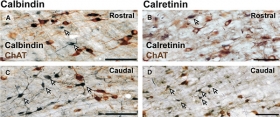Eur. J. Neurosci. 2012;35(5):723-34. 10.1111/j.1460-9568.2012.08002.x
Subpopulations of cholinergic, GABAergic and glutamatergic neurons in the pedunculopontine nucleus contain calcium-binding proteins and are heterogeneously distributed.
Full text PDF download:
Abstract:
Neurons in the pedunculopontine nucleus (PPN) are highly heterogeneous in their discharge properties, their neurochemical markers, their pattern of connectivity and the behavioural processes in which they participate. Three main transmitter phenotypes have been described, cholinergic, GABAergic and glutamatergic, and yet electrophysiological evidence suggests heterogeneity within these subtypes. To gain further insight into the molecular composition of these three populations in the rat, we investigated the pattern of expression of calcium binding proteins (CBPs) across distinct regions of the PPN and in relation to the presence of other neurochemical markers. Calbindin- and calretinin-positive neurons are as abundant as cholinergic neurons, and their expression follows a rostro-caudal gradient, whereas parvalbumin is expressed by a low number of neurons. We observed a high degree of expression of CBPs by GABAergic and glutamatergic neurons, with a large majority of calbindin- and calretinin-positive neurons expressing GAD or VGluT2 mRNA. Notably, CBP-positive neurons expressing GAD mRNA were more concentrated in the rostral PPN, whereas the caudal PPN was characterized by a higher density of CBP-positive neurons expressing VGluT2 mRNA. In contrast to these two large populations, in cholinergic neurons expression of calretinin is observed only in low numbers and expression of calbindin is virtually non-existent. These findings thus identify novel subtypes of cholinergic, GABAergic and glutamatergic neurons based on their expression of CBPs, and further contribute to the notion of the PPN as a highly heterogeneous structure, an attribute that is likely to underlie its functional complexity.